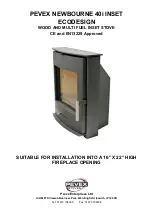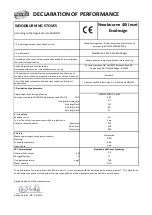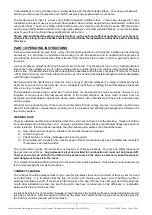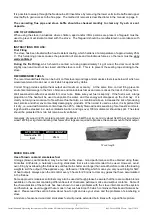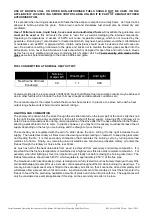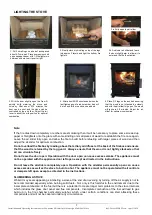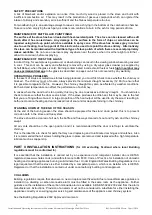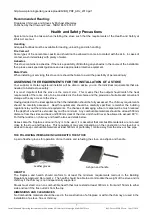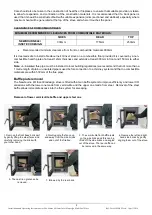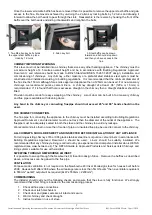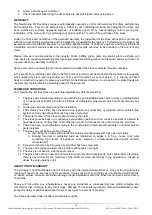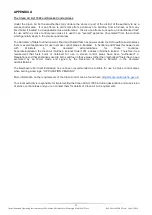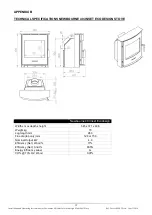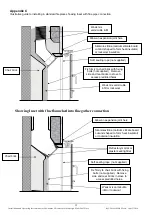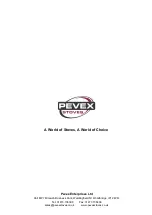
6
Installation and Operating Instructions for Newbourne 40i Inset Inset Ecodesign Multi Fuel Stove
Ref: Pevex1030/AH/ver1: 1 April 2019
SAFETY PRECAUTIONS
A risk of blowback and/or explosion can arise if too much dry wood is placed in the stove and burnt with
insufficient combustion air. This may result in the production of gaseous compounds which can ignite if the
intake of primary and secondary air is insufficient and the firebox temperature too low.
For woodburning it is an advantage always to leave some ash lying in the bottom of the combustion chamber.
Take care when emptying the ash pan, as cinders can continue to burn in the ash for long periods of time.
MAINTENANCE OF MATT BLACK PAINT FINISH
The surface of the stove has been treated with heat-resistant paint. The stove can be cleaned with a soft
brush after it has cooled down. Any damage to the surface in the form of chips or scratches can be
repaired using touch-up paint, which is available in spray cans. If the stove has become grey in colour
due to overheating, touch-up paint of this kind can be used to repaint the stove entirely. Alternatively,
the stove can be maintained with a traditional type of stove polish of which there are several proprietary
makes available
.
Do not use an aerosol spray anywhere near the stove when it is either alight or still hot
–
allow it to cool down before respraying.
MAINTENANCE OF THE STOVE GLASS
Incorrect firing, for example using wet wood, or slow burning can result in the viewing window becoming covered
in soot. This soot can be easily and effectively removed by using a dry wiper glass cleaner (as supplied by
Schott Robax), when the glass is cold. Burning contaminated, incorrect solid fuels or fuels
high in sulphur may
cause permanent damage
to the glass (as described on page 4) which is not covered by any warranty.
OPERATIONAL PROBLEMS
In the event of smoke or malodorous fumes being produced, you must first check to see whether the chimney is
blocked. The chimney must, of course, always provide the minimum draught necessary (12 Pa) to ensure that
it is possible to regulate the fire. However, the chimney draught may also be affected by weather conditions.
Both wind and temperature can affect the performance of a chimney.
In cases where the wood burns too quickly, this may be due to excessive chimney draught. You should also
check to make sure that the door seal is intact. If the stove produces too little heat, this may be due to the fact
that you are firing with wet wood. A large proportion of the heat output will be used to dry the wood, resulting in
both uneconomical heating and an increased risk of soot and tar deposits forming in the chimney.
STANDING DOWN AT THE END OF THE SEASON
At the end of the burning season the stove should be prepared for the stand down period, this is to prevent
corrosion both in the stove and flue system.
The stove should be cleared of all ash, the baffle and flue ways cleared of soot and fly ash and the chimney
swept.
All air vents should be in the open position and it is recommended that the door is left ajar to ventilate the
chimney.
This is the ideal time to check for parts that may need replacing and to lubricate door hinges and catches. Also
it is recommended that all screws holding the glass in place are removed and replaced with a high temperature
lubricant such as copper slip.
PART II INSTALLATION INSTRUCTIONS
(for UK excluding Scotland where local Building
regulations must be conformed to).
It is essential that the installation is carried out by an experienced and competent installer who is HETAS
registered (see www.hetas.co.uk) and with reference to BS 8303, Code of Practice for installation of domestic
heating and cooking appliances burning solid mineral fuel. Under England & Wales Building Regulations it is a
legal requirement that the stove is either installed by a competent person, which is an installer who is HETAS
Registered, or that the installation is carried out under Local authority building control approval.
CO ALARMS
Building regulations require that whenever a new or replacement fixed solid fuel or wood/biomass appliance is
installed in a dwelling a carbon monoxide alarm must be fitted in the same room as the appliance. Further
guidance on the installation of the carbon monoxide alarm is available in BS EN 50292:2002 and from the alarm
manufacturer’s instructions. Provision of an alarm must not be considered a substitute for either installing the
appliance correctly or ensuring regular servicing and maintenance of the appliance and chimney system.
See the Building Regulations 2002 Approved document J

